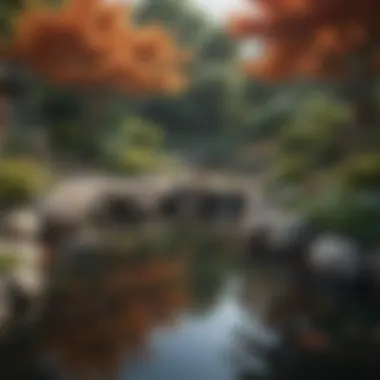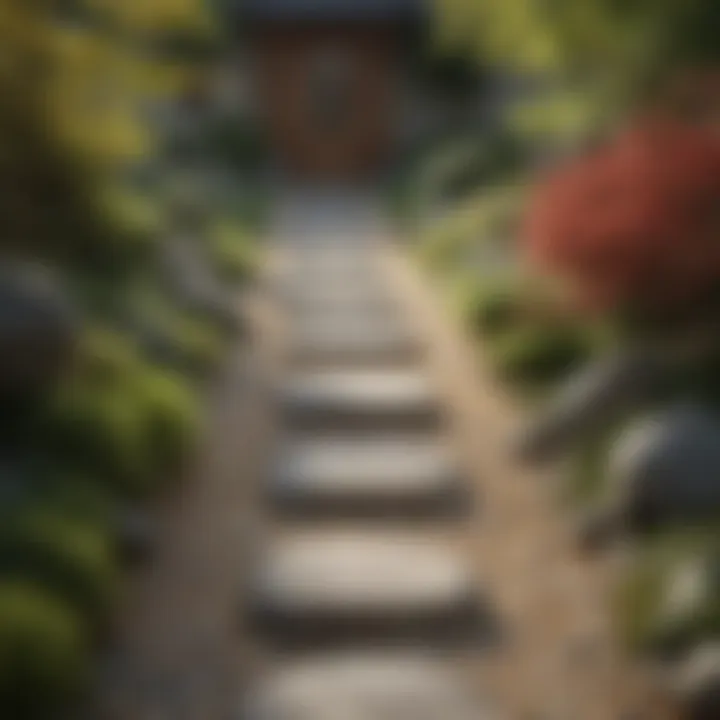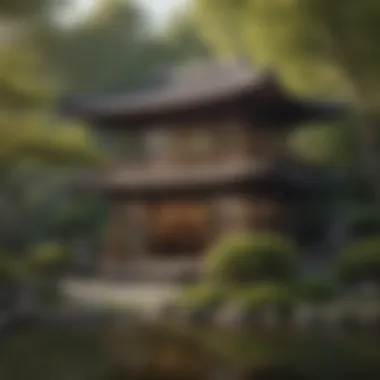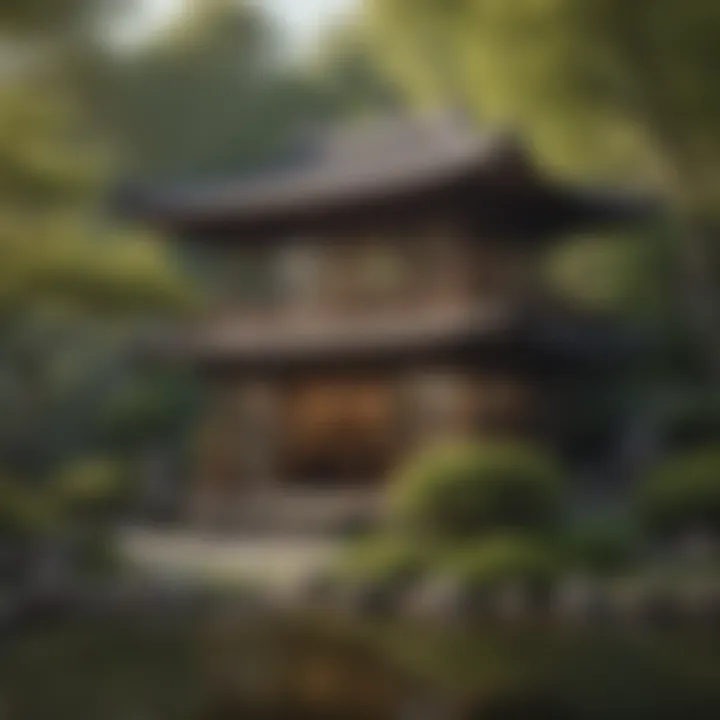Creating a Serene Backyard Japanese Garden


Intro
Creating a backyard Japanese garden is more than just landscaping. It involves understanding the historical and philosophical elements that make these gardens unique. This design method emphasizes harmony with nature, simplicity, and tranquility. This article will guide you through the process of designing such a garden while considering contemporary needs and lifestyles.
Design Inspiration
Key Design Principles
Japanese gardens embody several essential principles. They aim to create a cohesive connection between the landscape and the observer. Key components include the balance between elements, the use of natural materials, and an overall sense of serenity. Keeping these design principles at the forefront will set a solid foundation for your garden.
Plant Selection and Arrangement
The right choice of plants is crucial. The plants in a Japanese garden often represent more than aesthetic value. Consider traditional choices like cherry blossoms, maples, and bamboo. These plants bring seasonal change and symbolize key aspects of Japanese culture. Arranging them thoughtfully enhances the garden's flow and experience. Landscaping techniques such as layering, grouping, and varying heights can further elevate the visual appeal.
"A Japanese garden is not a place, but a feeling—a state of mind that evokes tranquility and harmony with nature."
Current Trends in Garden Design
Modern designs often incorporate minimalist aesthetics while also embracing sustainability. More homeowners are opting for gardens that require less maintenance yet still provide authentic tranquility. The integration of native plants can reduce water consumption and promote local biodiversity. These trends create a balance between tradition and modern living.
Gardening Techniques
Plant Selection and Care
Choosing the right plants is integral but understanding their care is equally important. Focus on plants that thrive in your local climate. For instance, if you live in a region with cold winters, choose hardy species that can survive the harsh weather. Regular maintenance like pruning and fertilizing will keep your garden looking vibrant.
Indoor vs. Outdoor Gardening
While traditional Japanese gardens are predominantly outdoor spaces, many homeowners seek to bring elements indoors. Terrariums and bonsai trees offer a piece of that tranquility within the home. Each space presents unique challenges and rewards. Outdoor gardens can focus on larger layouts, while indoor spaces need compact plant options. Mixing these elements can create an enriching experience, bringing the principles of Japanese design into your living space.
Understanding Japanese Gardens
Understanding Japanese gardens is vital in creating a backyard space that embodies serenity and balance. These gardens are not just simple landscapes but are deeply rooted in cultural heritage and philosophy. They offer more than aesthetic appeal; they are an expression of a way of life that connects humans to nature, fostering contemplation and tranquility. By grasping the core principles and themes that define Japanese gardens, one can effectively design a space that resonates with both traditional values and modern lifestyles.
Historical Context
Japanese gardens have a rich history that dates back to ancient Japan, influenced by various periods, such as the Asuka and Heian periods. Initially, they served as symbols of power and spirituality, designed for emperors and nobles. Over time, the Zen Buddhist philosophy permeated garden design, emphasizing simplicity and asymmetry. Each element in a Japanese garden serves a purpose, reflecting the traditions of the time and the beliefs of the people. The transition from grand palace gardens to more intimate ones, suitable for smaller spaces, marked a significant evolution. This history forms the foundation of why these gardens are celebrated today.
Cultural Significance
The cultural significance of Japanese gardens is profound. They embody the principles of harmony, balance, and respect for nature. In Japan, gardens are spaces for meditation and reflection, often used to encourage mindfulness. The integration of natural elements like water, stones, and plants reflects a deep connection to the environment. They also serve as a canvas for artistic expression, illustrating the changing seasons and the beauty of imperfection. Homeowners may find that creating a Japanese garden can bring a sense of peace and belonging, fostering a relationship with the environment that is both healing and restorative.
Philosophy and Aesthetics
The philosophy behind Japanese gardens emphasizes simplicity and naturalness. Aesthetically, they focus on subtle beauty rather than vibrant displays. Elements such as asymmetry and irregularity are crucial, as they reflect nature's randomness. Gardens are designed to be viewed from specific angles, creating a sense of discovery and surprise. This careful consideration makes every visit to the garden unique. The use of color and texture further enhances the sensory experience, offering moments of quiet contemplation.
"A Japanese garden is a small representation of a universe in balance, where human creativity meets natural serenity."
Designing with these principles in mind fosters an outdoor space that not only adheres to traditional guidelines but also respects the personal preferences and lifestyles of modern homeowners. Understanding these facets of Japanese garden design lays the groundwork for a carefully cultivated outdoor sanctuary.
Key Elements of a Japanese Garden
Creating a Japanese garden involves incorporating several key elements that contribute to its unique beauty. The design and implementation of these elements are not only essential for aesthetic appeal but also for fostering the intended ambiance of tranquility and reflection. It’s important to consider how these elements harmonize within the garden space, allowing for a fluid interaction between nature and man-made structures.
Water Features
Types of Water Features
Water features hold a vital role in a Japanese garden. They symbolize purity and calmness, contributing to the overall atmosphere of serenity. Common types include ponds, streams, and waterfalls. Each type serves a distinct purpose in the landscape. For instance, ponds can act as a habitat for koi fish, while waterfalls provide the soothing sound of running water. These elements not only enhance visual interest but also introduce a dynamic aspect to the setting. However, constructing and maintaining water features can require significant effort and resources, which should be planned accordingly.
Placement and Design
The strategic placement and design of water elements are crucial. Ideally, water should be positioned to be enjoyed from various vantage points throughout the garden. The design should integrate naturally with the surrounding environment, ensuring that it complements plantings and hardscape features. Additionally, thoughtful design can help with water management, making the system sustainable and reducing care needs. Still, one must carefully consider the balance in water placement; an overabundance can create a cluttered look which detracts from the garden’s intended tranquility.
Plants Selection
Traditional Plants
Using traditional plants is a fundamental aspect of a Japanese garden. Species like cherry blossoms, maples, and azaleas are often favored for their historical significance and natural beauty. These plants contribute to the authenticity of the garden, helping to convey its cultural narrative. The choice of plants must align with the principles of simplicity and minimalism that characterize Japanese aesthetics. However, traditional plants may not always be native to every region, raising concerns about adaptability and long-term survival in some climates.
Seasonal Considerations
Seasonal considerations in plant selection ensure that the garden remains visually appealing year-round. This involves choosing varieties that provide color and interest across different seasons. For example, certain evergreens may offer lush greenery in winter, while flowering plants deliver vibrant colors in spring and summer. This approach enhances the garden's dynamism, allowing it to transform through the seasons. Nonetheless, accommodating seasonal changes may require more extensive planning and maintenance.
Foliage Color and Texture


The interplay of foliage color and texture plays an important role in creating the aesthetic of a Japanese garden. Varied colors and textures can bring depth and interest to the landscape. For example, the contrast between the soft, feathery leaves of a Japanese maple and the crisp lines of bamboo creates an engaging effect. However, achieving this balance requires careful selection to avoid clashes in color, which could disrupt the garden’s harmonious nature.
Hardscaping
Pathways
Pathways in a Japanese garden guide visitors and enhance the overall layout. They should be designed to encourage slow, deliberate movement, allowing for mindfulness and appreciation of the surroundings. Materials like gravel, stone, or wood can create a natural look that blends with the environment. The design of these pathways directly contributes to the usability of the garden while maintaining its quiet appeal. However, poorly laid pathways can lead to uneven surfaces, creating safety concerns.
Bridges
Bridges can serve as both functional and ornamental elements. They often cross over water features, creating visual connections and inviting exploration. In a Japanese garden, the design of the bridge should complement its surroundings, maintaining the theme of harmony and balance. A well-placed bridge can become a focal point, drawing the gaze of visitors. Nevertheless, careful construction is necessary; an improperly built bridge risks becoming unstable and detracting from the garden's quality.
Stones and Gravel
The use of stones and gravel is a hallmark of Japanese gardens. Stones can represent mountains or islands, forming a crucial visual component. Gravel, often raked into patterns, symbolizes water ripples, contributing to the garden's meditative qualities. These materials add texture and structure without overwhelming the natural beauty of the plants. However, maintaining the integrity of these hardscaping elements can necessitate consistent effort to keep everything appearing tidy.
Ornaments and Structures
Lanterns
Lanterns serve both a practical and aesthetic purpose in a Japanese garden. They provide illumination at night, casting a soft light that enhances the serene atmosphere. Traditionally, lanterns are made from stone or metal and can vary in design, adding character to the garden. Their placement should align with the pathways, guiding visitors through the garden at night. Since they usually require minimal maintenance, lanterns are a popular choice among gardeners.
Tea Houses
Tea houses are iconic structures in the Japanese garden. They provide a place for tea ceremonies, fostering a connection with nature and contemplation. The design of a tea house should promote relaxation, integrating natural materials to create a seamless link with the environment. Owning a tea house can deepen one’s appreciation for the garden, but constructing one requires substantial investment and space.
Screens
Screens are used to create privacy and define spaces within the garden. They can be constructed from wood, bamboo, or other natural materials, offering a sense of seclusion. This element is particularly useful in smaller yards where defining different areas enhances the overall design. However, choosing the right material and design is crucial; poorly placed screens can obstruct views rather than enhance them.
Design Principles
Design principles play a crucial role in the creation of a backyard Japanese garden. They guide the layout, placement of elements, and overall harmony of the space. The design is not just about aesthetics; it is about creating an environment that enhances the connection between nature and the observer. When applied thoughtfully, these principles contribute to a peaceful and serene atmosphere that reflects traditional Japanese philosophy.
Balance and Harmony
Balance and harmony are fundamental in a Japanese garden. The notion of balance does not necessarily require symmetry; instead, it emphasizes the distribution of visual weight. The elements in the garden should interact in a way that feels natural and effortless. This leads to a sense of calm and tranquility.
Consider how each part of the garden complements the others. For example, a small pond can balance a cluster of rocks or a group of plants. Different heights and shapes of plants distribute visual weight evenly and provide a pleasing effect. In essence, a well-balanced garden makes the whole space feel cohesive.
"A harmonious garden creates a dialogue between the crafted elements and the natural surroundings."
Asymmetry
Asymmetry is another key design principle in Japanese gardens. Unlike Western gardens that often emphasize symmetry, Japanese gardens embrace unevenness. This principle creates a more organic feel that mirrors nature. Asymmetrical design often encourages movement through the space, inviting exploration.
When applying asymmetry, consider varying heights, shapes, and spacing. For example, place a taller plant next to shorter ones, or position a large rock offset from the center of a path. This can evoke a sense of spontaneity that adds to the garden's charm. Asymmetry speaks to the natural world’s imperfections, illustrating that beauty can be found in the unexpected.
Color and Texture Contrast
The use of color and texture contrast adds depth and interest to a Japanese garden. This principle is not simply about choosing bright colors. Instead, it is about carefully selecting plants and materials that complement each other.
When selecting plants, think about seasonal blooms and their colors. A cherry blossom tree in spring brings beauty surrounded by evergreen shrubs. Additionally, varying leaf shapes and surface textures create visual intrigue. For example, the smoothness of Japanese maple leaves contrasts beautifully with the rough texture of certain rocks.
In hardscaping, use materials like bamboo, stone, and gravel. Combining these elements can create a rich tapestry of color and tactile experiences. The contrasts can transform the garden into a multi-sensory space that captivates those who enter.
In summary, understanding design principles like balance and harmony, asymmetry, and color and texture contrast enhances the homeowner’s ability to create a backyard Japanese garden that reflects both aesthetic beauty and philosophical depth.
Spatial Layout
The spatial layout of a backyard Japanese garden is crucial for achieving the intended aesthetic and functional goals. It intertwines harmony, movement, and psychological peace. A well-thought garden layout can create spaces that encourage tranquility, contemplation, and connection with nature. This layout is framed by both natural elements and human-made structures, often balancing them seamlessly.
Zoning the Garden
Zoning refers to the deliberate division of the garden into distinct areas or sections, each serving a specific purpose. This concept not only organizes the space effectively but also enhances the visual appeal.
To successfully zone a Japanese garden, consider the following:
- Establish areas for meditation, walking, and viewing.
- Use plants and structures like rocks or gardens to define boundaries.
- Ensure dynamic interactions between zones, allowing for movement and flow.
Zoning enables the gardener to create areas that inspire different emotions, from vibrant activity in an open space to a secluded nook for relaxation.
Circulation Paths
Circulation paths are fundamental to the layout. They guide the visitor through the garden, providing direction and enhancing exploration. In traditional Japanese gardens, paths often follow natural curves, mirroring the gentle waves of nature itself.


When establishing circulation paths, consider these elements:
- Use natural materials such as stone or gravel to blend with the environment.
- Create variety in path width, leading to an inviting feeling.
- Implement indirect paths to encourage slow, contemplative movement.
Such paths not only enhance aesthetic value but also facilitate graceful transitions between different zones of the garden.
Creating Nooks for Contemplation
Nooks provide intimate spaces for reflection, critical in Japanese garden design. They are often small, secluded areas created by thoughtful plant arrangements or architectural elements.
To create effective contemplation nooks:
- Choose low, dense plants to enclose the space, fostering privacy.
- Incorporate seating areas with simple benches or stones for tranquility.
- Position these nooks near water features to further enhance the calming atmosphere.
When designed well, these areas invite the visitor to pause, reflect, and appreciate the garden in a deeper manner.
Designing the spatial layout with these considerations not only honors traditional practices but also invites modern sensibilities. Think of it as a canvas for serenity and peace.
Practical Considerations
Site Assessment
A comprehensive site assessment is the starting point for any garden project. This step involves evaluating the physical characteristics of your property, including the size, shape, and topography of the area you plan to develop. By understanding these aspects, you will make informed choices for design elements such as pathways, plant placement, and water features.
Consideration of the sun's path is essential. Observe how sunlight moves across your yard throughout the day. Identify areas that receive full sun, partial shade, and full shade. This knowledge will influence the selection of plants, as certain species thrive in varying light conditions. Additionally, assess the wind patterns, as this can affect the microclimate needed for your chosen plants.
Soil and Drainage
The quality of soil in your garden matters greatly. Japanese gardens often feature meticulous plantings and designs that require healthy soil for optimal growth. First, conduct a soil test to ascertain pH levels and nutrient content. A balanced soil offers the best foundation for plants, allowing them to flourish.
Drainage is another critical component. Excess water can easily harm delicate plants, leading to root rot and other issues. Ensure your garden has proper drainage systems in place. You might choose to incorporate raised beds or install drainage tiles to help direct water away from plant roots. Using gravel or sand in planting areas can also enhance drainage and promote plant health.
Climate Adaptations
Climate is crucial when determining which plants to include in your Japanese garden. Understanding the local climate enables you to select species that will adapt well. Each plant variety comes with its own requirements regarding temperature, moisture, and sunlight. Therefore, studying your hardiness zone can guide your choices efficiently.
Additionally, factor in seasonal changes. Some plants may offer beautiful blooms in spring, while others may provide interest through their foliage in fall. Using a mix of plant types will ensure that your garden remains visually appealing throughout the year. Implementing mulch can also help moderate temperature extremes, retain moisture, and suppress weeds.
Practical considerations ensure that the garden not only looks aesthetically pleasing but is also sustainable and functional for year-round enjoyment.
By conducting a thorough site assessment, ensuring good soil quality and drainage, and adapting to the climate, you establish a robust foundation for your backyard Japanese garden. These basic principles help to foster a garden environment that harmonizes with the natural world around it.
Planting Strategies
Layering Plants
Layering plants creates a harmonious and balanced landscape. This technique involves organizing plants in tiers, which provides depth and visual interest. Typically, taller plants are placed at the back or center, while shorter ones occupy the front or edges.
- Height Variation: By incorporating plants of different heights, you can guide the viewer’s eye throughout the garden. For instance, tall pines or bamboo can form a backdrop that showcases lower shrubs and ground cover.
- Diverse Foliage: Include a mix of evergreen and deciduous plants. This layering approach ensures visual interest year-round. Evergreen plants provide structure in winter, while deciduous plants may offer vibrant colors in fall.
- Sunlight Accessibility: Consider the sunlight requirements of each plant. Layering assists in maximizing light exposure. Position tall plants away from those needing more sun, ensuring that each layer thrives well.
Companion Planting
Companion planting is another essential planting strategy that supports ecological balance. This method involves planting species together that mutually benefit one another. In a Japanese garden, this technique enhances plant health and aesthetics.
- Pest Control: Certain plants can deter pests when planted alongside vulnerable species. For example, incorporating marigolds can help protect neighboring plants.
- Soil Improvement: Some plants enhance soil quality. Leguminous plants, such as clover or peas, can fix nitrogen in the soil and promote healthier growth for surrounding flora.
- Aesthetic Cohesion: Choosing companion plants that complement each other visually adds to the overall appeal. Look for contrasting leaf shapes or colors to enrich the garden’s texture and color palette.
Seasonal Color Schemes
Implementing seasonal color schemes allows a Japanese garden to evolve throughout the year. This technique gives emphasis to the changing seasons, a fundamental aspect of Japanese garden philosophy.
- Spring Blooms: For a vibrant display, incorporate flowering cherries and azaleas that bloom in spring. These can create a burst of color after winter’s bleakness.
- Summer Foliage: As spring fades, diverse greens dominate. Use plants like hakone grass or hosta to provide lush greenery, which is soothing to the eye.
- Autumn Colors: Transitioning to autumn, trees like the Japanese maple exhibit stunning fall foliage. Selecting plants with varied autumn leaves can continue to enhance the garden’s allure.
- Winter Interest: Even in winter, plants should offer something visually engaging. Evergreens, along with ornamental grasses, can stand out against snow or frost, maintaining beauty during colder months.
Maintenance Practices
Maintaining a Japanese garden involves continual care and thoughtful practices. These gardens are not merely ornamental; they reflect a philosophy of balance, tranquility, and the beauty of nature. Regular maintenance ensures that the garden remains a serene, inviting space. It also helps to preserve the garden's intended aesthetic and ecological balance.
An effectively maintained Japanese garden allows for the natural cycles of life while also adhering to the principles of design that define its essence.
Pruning Techniques
Pruning is a vital practice in any garden, particularly in a Japanese garden. This technique shapes plants, encourages healthy growth, and enhances the overall appearance. The focus is on creating clean lines and focal points without over-manipulating nature. Techniques such as selective pruning allow for the maintenance of the natural form of plants, especially traditional species like the Japanese Maple. By pruning out dead or crowded branches, you invite sunlight into the interior of the plant, enhancing its health and appearance.
- Timing: Different plants have unique seasonal needs for pruning. Understand these needs to avoid damaging growth.
- Tools: Use sharp, clean tools to make precise cuts. This helps prevent disease and promotes quicker healing.
- Technique: Aim for cuts that respect the natural growth patterns of each plant, avoiding drastic reductions that can shock the plant.
Weed Management


Weed control is vital for protecting the delicate ecosystems often found in Japanese gardens. Weeds compete for resources and can detract from the beauty of the designed landscape. A proactive approach is essential to maintain harmony and focus within the garden.
- Mulching: Apply a thick layer of mulch to suppress weed growth effectively while also retaining moisture in the soil.
- Hand Pulling: Regularly inspect the garden and remove weeds by hand. This is especially effective for smaller areas and delicate plants.
- Natural Herbicides: If necessary, consider using organic herbicides that are safe for the environment, preserving the garden's integrity.
Seasonal Care Routines
Incorporating a routine care schedule throughout the seasons enhances the health and appearance of a Japanese garden. Each season presents unique tasks and considerations to maintain the beauty of the garden.
- Spring: This is a time for planting and pruning. Prepare the soil and ensure proper drainage after winter.
- Summer: Focus on watering and weeding. Established plants will require less water while newly planted ones need regular checks.
- Autumn: This season calls for raking fallen leaves and preparing plants for colder weather. Prune any overgrown branches to allow sunlight in.
- Winter: While the garden may appear dormant, protective measures should be taken. Wrap vulnerable plants and clear heavy snow from branches to prevent damage.
Incorporating Modern Elements
In the design of a backyard Japanese garden, it is essential to explore how modern elements can be integrated meaningfully. While traditional Japanese gardens emphasize simplicity and natural beauty, today’s homeowners often seek to combine these principles with contemporary aesthetics. This fusion can enhance both functionality and visual appeal, making it more relevant to modern lifestyles.
Blending Traditions with Modernity
Blending traditions with modern designs provides a unique opportunity to create a hybrid garden space that respects the core values of Japanese gardening while allowing for personal expression. For instance, one might incorporate sleek, minimalist structures, such as glass or metal features, that contrast traditional materials like wood and stone. This juxtaposition creates visual interest and allows for a modern interpretation of classic designs.
A key consideration in this blending process is maintaining balance. It is important that modern elements do not overwhelm the garden's tranquil atmosphere. When adding contemporary features, think about:
- Materials: Use natural materials that resonate with traditional aesthetics, such as bamboo or granite, combined with modern materials like steel.
- Textures: Differentiate textures by introducing smooth surfaces alongside natural ones, creating an engaging tactile experience.
- Forms: Implement geometric shapes that mirror the simplicity found in Japanese gardens, ensuring they harmonize instead of clash.
Sustainable Practices
Sustainability is an important aspect when incorporating modern elements into a Japanese garden. By focusing on eco-friendly practices, gardeners can create spaces that are both beautiful and sustainable. Here are some ideas:
- Native Plants: Use plants that are indigenous to your area. These plants typically require less water and support local wildlife.
- Rainwater Harvesting: Consider installing systems that collect rainwater. This practice can be used to nourish your garden without relying solely on municipal water supplies.
- Composting: Implement a composting system for organic waste. This can reduce refuse and provide nutrients to the soil.
Exploring Variations
In the journey of creating a backyard Japanese garden, understanding the various styles and themes is crucial. Each variation offers unique benefits, aesthetic nuances, and practical considerations that cater to different homeowner preferences and environmental contexts. Exploring these variations allows for personalization, ensuring that the garden not only reflects traditional principles but also fits seamlessly within contemporary living.
Zen Gardens
Zen gardens, also known as karesansui, epitomize simplicity and tranquility. Characterized by minimalism, these gardens typically lack water features and focus instead on gravel, stones, and carefully placed elements. The raked gravel represents water ripples, providing a meditative space for reflection.
One key aspect of Zen gardens is their need for careful maintenance. Regular raking ensures that the patterns remain sharp and distinct, encouraging mindfulness. However, while maintaining simplicity, you should think about the placement of rocks and gravel. Each element serves a purpose and contributes to the overall harmony.
The benefits of a Zen garden include:
- Promoting meditation: The calmness of the design helps in reducing stress.
- Low water usage: This makes it a sustainable choice.
- Adaptability: Zen gardens can fit in various spaces, making them suitable for urban environments.
Tea Gardens
Tea gardens hold a special significance in Japanese culture. They are designed to create a welcoming space for enjoying tea ceremonies, emphasizing a connection to nature and seasonal change. These gardens often include winding paths that lead guests through lush plantings, deliberately arranged to evoke harmony and balance.
Key features typically found in tea gardens include:
- Secluded seating areas: These offer spots for quiet reflection.
- Variety of plants: Include azaleas, camellias, and bamboo, which bloom at different times of the year, ensuring year-round interest.
- Water elements: Small ponds or streams help create lively soundscapes while reflecting surrounding beauty.
By incorporating a tea garden into your backyard, you foster a space for social gatherings and peaceful moments alike, integrating culinary culture with nature.
Forest Gardens
Forest gardens are designed to mimic natural ecosystems. They can be seen as a rich tapestry of plants, combining trees, shrubs, and perennials in layers, each offering a unique texture and color. This style not only promotes biodiversity but also creates a habitat that supports local wildlife.
Considerations for forest gardens include:
- Diversity of plants: Choose native species to reduce maintenance and enhance local ecology.
- Layered planting: This helps create a lush environment while optimizing space effectively.
- Natural pathways: Define routes through the planting for a sense of adventure and exploration.
Forest gardens provide the following advantages:
- Eco-friendly: They contribute to local ecosystems and promote sustainability.
- Edible crops: Many forest gardens incorporate fruit-bearing trees or edible plants into their design.
- Year-round interest: Seasonal changes provide a dynamic visual experience.
Forest gardens not only serve aesthetic purposes; they hold ecological value by supporting biodiversity, making them a thoughtful addition to any backyard layout.
Finale
Creating a backyard Japanese garden is not merely an aesthetic endeavor; it encompasses a journey of personal growth and harmony with nature. Throughout this article, we have emphasized the historical significance, essential elements, and practical considerations that are critical for successful implementation. These gardens symbolize a deep cultural understanding and appreciation of nature, offering more than just beauty; they provide tranquility and a retreat from the stresses of modern life.
Reflecting on Your Garden Journey
As you stand gazing at your finished garden, consider the effort and intention that went into each decision. This reflection can be enlightening, as it showcases not just the physical transformation of your outdoor space, but also the personal insights gained along the way. Creating a Japanese garden requires understanding its values of simplicity, balance, and harmony, but it also provides an opportunity to connect with your inner self.
Engaging in this journey allows homeowners to:
- Discover their preferences in design elements and plant selections.
- Cultivate a sense of mindfulness while working in the garden.
- Appreciate the changes in nature through the seasons, enhancing overall well-being.
Moreover, your garden can serve as a place for contemplation, meditation, and connection with family or friends. Consider setting up areas specifically designed for quiet reflection, encouraging genuine connection with oneself and nature. The sequential process of planting, designing, and nurturing your garden reflects a broader experience of commitment and patience, mirrorimg the natural cycles of life.
"The journey of creating a Japanese garden is a constant interplay between nature, design, and personal growth."
In sum, the act of designing and maintaining a backyard Japanese garden is enriching, offering both aesthetic pleasure and introspective moments. As you embark on this journey, remember that every stone laid and plant nurtured contributes to a larger narrative of tranquility and peace.



